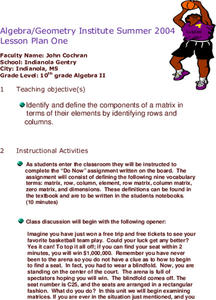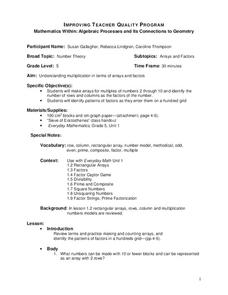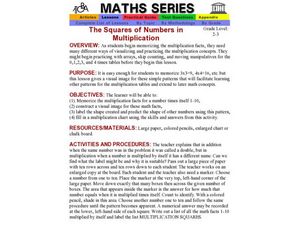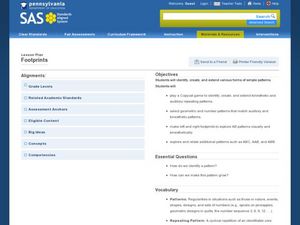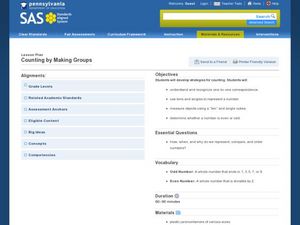Houghton Mifflin Harcourt
Unit 2 Math Vocabulary Cards (Grade 4)
The 28-page resource contains cards with terms relating to multiplication from inverse operations to front-end estimation to array. Each sheet contains two cards; one with the word and one with the definition.
Curriculum Corner
Academic Math Vocabulary
The ABCs of math are so important. Find commonly used math terms in a 42-page packet. Each page has the word, a place to write the definition, and a place to give specific examples of the term. A must-have for all math classrooms!
Curated OER
Relating Multiplication and Division
Help the class determine missing factors in equations by creating arrays. Through modeling and practice, they come to see the inverse relationship between multiplication and division. As an assessment, individuals build their own array...
Yummy Math
Sweethearts Candy
Sweethearts® candies are a beloved Valentine's Day treat—so much so that eight billion hearts are produced every year around the world! Learners use number sense reasoning and critical thinking to solve nine word problems about the...
Illustrative Mathematics
“One More” Concentration
Help your primary learners develop an understanding of the concept of one more and one less using two sets of number cards. The first set of cards, all in one color, is the "one less" deck. The second set, again all in one specific...
Curated OER
Measure the Gardens
Understanding arrays is very similar to understanding the relationship between multiplication and area. Give your third graders an opportunity to practice identifying area models that relate repeated addition and multiplication. They...
Curated OER
Matrices
Learners explore matrices. Given a particular situation, they discover the make-up and design of a matrix. Students identify examples of rectangular arrays used in real world situations. They solve oral problems in class.
Curated OER
Prime and Composite Numbers
Fifth graders use prime factorization to identify prime and composite numbers. They use cubes to find factors. In groups, 5th graders draw rectangular arrays to discover prime numbers under 100.
Curated OER
Mathematics Within: Algebraic Processes and Its Connections to Geometry
Fifth graders discover the connections between algebra and geometry. With a focus on arrays and factors, they are introduced to multiplication. They develop an array for multiples of 2 through 10 and identify the factors of each row....
Curated OER
The Squares of Numbers in Multiplication
Students make multiplication squares. For this math lesson, students review their multiplication facts and multiplication strategies. Students are introduced to multiplication squares when multiplying a number by itself.
Mr. Waynes clas
Kinematics Objectives
Accelerate young physicists' learning with this collection of problem-solving worksheets. Starting off by teaching students to identify the given information and variables in physics problems, this resource goes on to challenge them...
Curated OER
Number Patterns
Help your students to identify even and odd numbers. In this number sense lesson, they read the book Madeline and use counters to identify which number has a "partner." Learners write down odd and even numbers on a whiteboard.
Curated OER
Solving Problems
Second graders become familiar with need strategies for computation of money problems and estimating sums. In this computation lesson plan, 2nd graders solve real life problems to understand estimation and money problems.
Curated OER
Footprints
Students explore patterns. In this patterns geometry lesson, students identify and extend patterns including body parts, movement, geometric shapes, noises, and footprints. Students create and share an original pattern.
Curated OER
Counting by Making Groups
First graders represent, compare, and order numbers. In this counting skills lesson, 1st graders use manipulatives to demonstrate one-to-one correspondence and to represent numbers. This lesson includes a teacher script to guide the lesson.






